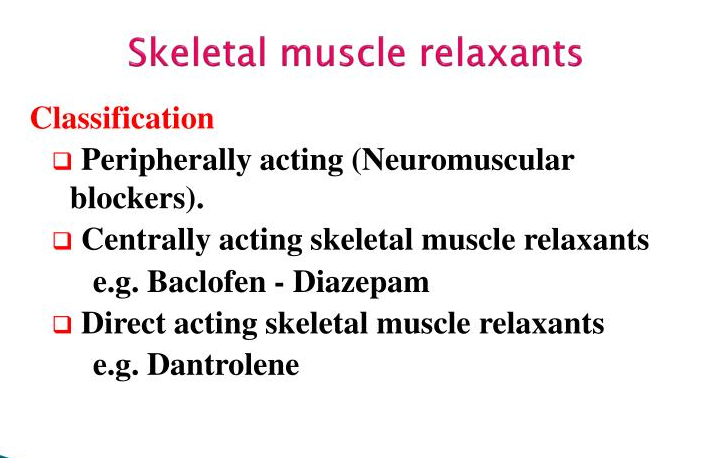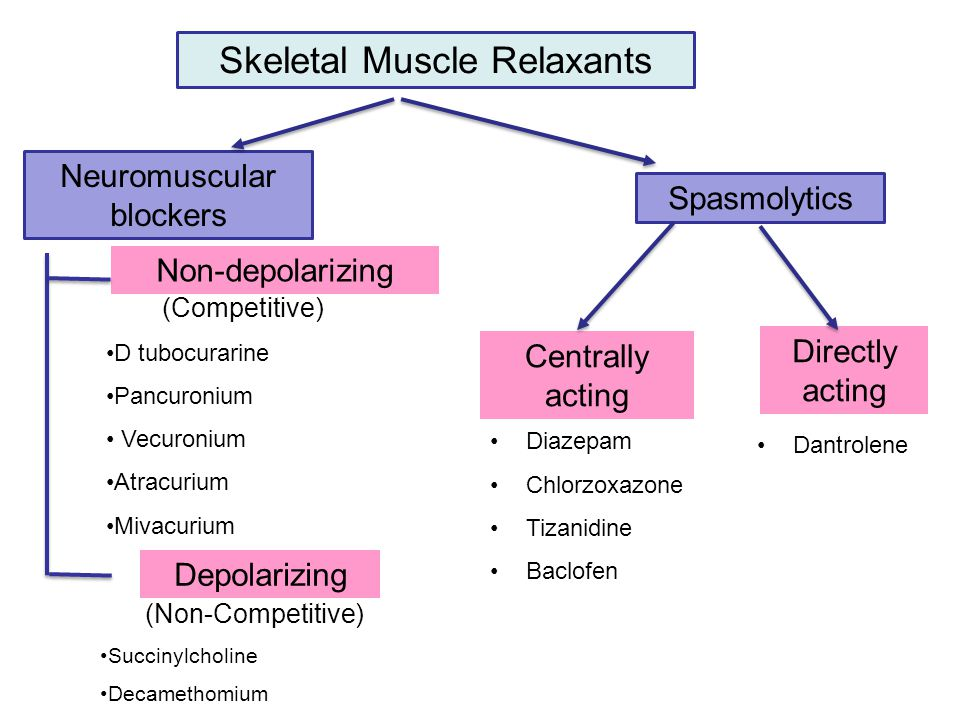Muscle relaxers, or muscle relaxants, are medications used to treat muscle spasms or muscle spasticity.

Skeletal muscle relaxants are drugs that are used to relax and reduce tension in muscles. They are more simply referred to as muscle relaxants.
Some work in the brain or spinal cord to block or dampen down excessively stimulated nerve pathways. These are called centrally acting muscle relaxants and examples include baclofen, methocarbamol, and tizanidine.

Others act directly on muscle fibers and are classified as peripherally acting muscle relaxants. Examples include dantrolene and the different types of botulinum toxin. Although dantrolene acts directly on the muscle itself, it also appears to indirectly act on the central nervous system and can cause drowsiness.
Cannabis extract also has muscle relaxing properties and is thought to act both centrally and peripherally.
Muscle spasms or cramps are sudden, involuntary contractions of a muscle or group of muscles. They can be caused by too much muscle strain and lead to pain. They’re associated with conditions such as lower back pain, neck pain, and fibromyalgia.
Muscle spasticity, on the other hand, is a continuous muscle spasm that causes stiffness, rigidity, or tightness that can interfere with normal walking, talking, or movement. Muscle spasticity is caused by injury to parts of the brain or spinal cord involved with movement. Conditions that can cause muscle spasticity include multiple sclerosis (MS), cerebral palsy, and amyotrophic lateral sclerosis (ALS).
Prescription drugs can help relieve the pain and discomfort from muscle spasms or spasticity. In addition, certain over-the-counter medications may be used to treat aches and pains associated with muscle spasms.
What are skeletal muscle relaxants used for?
Skeletal muscle relaxants are mainly used to treat:
- spasticity, which is another term for stiff and rigid muscles caused by conditions such as cerebral palsy, multiple sclerosis, or stroke
- muscle spasms which are temporary muscular contractions that are often associated conditions such as tension headache, low back pain, or fibromyalgia
- cervical dystonia – a painful condition where the neck muscles involuntarily contract, causing your head to uncontrollably tilt forward or backward.
Which Prescriptions are skeletal muscle relaxants?
Skeletal muscle relaxants differ in the way they work (centrally or peripherally as discussed above), their side effects, and their effectiveness for certain conditions.
Note that several other medicines, notably diazepam, may also be used as a muscle relaxant and are not listed below.
Note that several other medicines, notably diazepam, may also be used as a muscle relaxant and are not listed below.
| Generic name | Brand name | FDA approval (spasm-related) |
|---|---|---|
| abobotulinumtoxinA | Dysport | Cervical dystonia, Muscle spasms |
| baclofen | Gablofen, Lioresal | General spasticity |
| carisoprodol | Soma, Vanadom | Muscle spasms |
| chlorzoxazone | Lorzone | Muscle spasms |
| cyclobenzaprine | Amrix, Flexeril, Fexmid | Muscle spasms |
| dantrolene | Dantrium | General spasticity |
| onabotulinumtoxinA | Botox | Cervical dystonia, Muscle spasms |
| orphenadrine | Norflex | Muscle spasms |
| metaxalone | Skelaxin | Muscle spasms |
| methocarbamol | Robaxin | Muscle spasms |
| rimabotulinumtoxinB | Mybloc | Cervical dystonia |
| tizanidine | Zanaflex | General spasticity |
Are skeletal muscle relaxants safe?
Evidence supporting the effectiveness of skeletal muscle relaxants for muscle spasm is sparse; most trials are old and not of good quality.
Skeletal muscle relaxants consist of a varied range of medicines and some may not be suitable for people with certain medical conditions such as an enlarged prostate, epilepsy, glaucoma, intestinal problems, liver or kidney disease, or myasthenia gravis. Many also interact with other medications.
Some, like dantrolene, can adversely affect the liver and blood samples should be taken before treatment to check for any pre-existing liver disease or to establish how well the liver is functioning before treatment, and what effect the drug subsequently has.
Muscle relaxants can affect overall muscle tone and may be dangerous if muscle tone is needed for safe balance or movement. Alcohol can enhance these effects. Many muscle relaxants need to be tapered off slowly, rather than abruptly stopped.